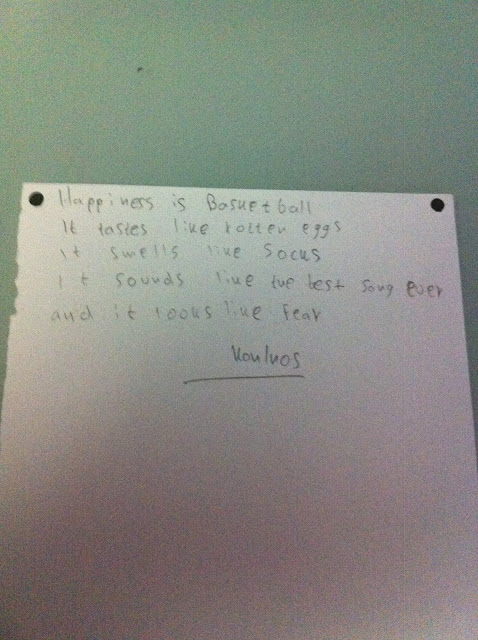It all started with a lesson plan based on an activity from Günter Gerngross, Herbert Puchta and Scott Thornbury's "Teaching Grammar Creatively". The activity aimed at teaching verbs of the senses-looks, sounds, smells, tastes, feels-a problematic area for students, at least the way it was presented in the school book of 6th grade.I needed something to make an impression, to stay with them after the lesson. So after the presentation and the consolidation I decided to try something I had never tried with this class before. Ask them to write poetry. When I started explaining the activity I was not at all sure if everybody would be able to cope with it. In fact, I thought that some students may even start nagging or refuse to do it.To my surprise, nothing of the above happened. On the contrary, the moment I explained what they had to do everybody-and I mean everybody-set to work. Some of them asked to work in pairs and I didn't mind this.
So adapting the activity a little, first I gave them a model text to fill in with the verbs of senses. Here's the model text:
Happiness is the colour of poppies in spring.
It________ like chocolate ice cream.
It ________ like peach blossom.
It ________ like the cry of an eagle.
And it __________ like the wide open sky.
After we filled in the gaps-that was too easy for them-I kept this on the board:
Happiness is the colour of poppies in spring.
It tastes like ________________________.
It smells like _______________________.
It sounds like _______________________.
And it looks like _____________________.
and told them this was their model poem to complete.
It didn't take us long. It was like everyone felt so ready, so eager to write about happiness.
When I went home and read the poems I was so touched! So proud of them! And I have to admit they really surpised me! Their poems were works of art!
All this taught me something that I sometimes forget although I see it very often! That students are at their best when they are able to express themselves in the foreign language, create with their existing knowledge . Also, they are proud to present their products to their classmates.
So we should give them opportunities to be creative in the classroom more often. Sometimes these things we are afraid to try are the ones that give the best outcomes.
Some useful advice before you try using poetry with your class is to make it clear to students that poems don't have to rhyme to be poetry. Free poetry without rhymes is a type of poetry they could also experiment with. Poetic expression doesn't necessarily call for rhyming. In fact, you can even express yourself poetically in a story or an essay.Poetry is just a way of expression, unique and specific to everyone's perception of the outer world, beauty of the inner world, experiences and feelings.
Good luck!
And I proudly present our poems:
1st Primary School of Amyntaio
6th grade School year 2015-2016
A note here-that may contribute to this poem's comprehension-is that one of the students has a little baby sister at home!
So adapting the activity a little, first I gave them a model text to fill in with the verbs of senses. Here's the model text:
Happiness is the colour of poppies in spring.
It________ like chocolate ice cream.
It ________ like peach blossom.
It ________ like the cry of an eagle.
And it __________ like the wide open sky.
After we filled in the gaps-that was too easy for them-I kept this on the board:
Happiness is the colour of poppies in spring.
It tastes like ________________________.
It smells like _______________________.
It sounds like _______________________.
And it looks like _____________________.
and told them this was their model poem to complete.
It didn't take us long. It was like everyone felt so ready, so eager to write about happiness.
When I went home and read the poems I was so touched! So proud of them! And I have to admit they really surpised me! Their poems were works of art!
All this taught me something that I sometimes forget although I see it very often! That students are at their best when they are able to express themselves in the foreign language, create with their existing knowledge . Also, they are proud to present their products to their classmates.
So we should give them opportunities to be creative in the classroom more often. Sometimes these things we are afraid to try are the ones that give the best outcomes.
Some useful advice before you try using poetry with your class is to make it clear to students that poems don't have to rhyme to be poetry. Free poetry without rhymes is a type of poetry they could also experiment with. Poetic expression doesn't necessarily call for rhyming. In fact, you can even express yourself poetically in a story or an essay.Poetry is just a way of expression, unique and specific to everyone's perception of the outer world, beauty of the inner world, experiences and feelings.
Good luck!
And I proudly present our poems:
1st Primary School of Amyntaio
6th grade School year 2015-2016
A note here-that may contribute to this poem's comprehension-is that one of the students has a little baby sister at home!
Resources:
Book: Teaching Grammar Creatively-Günter Gerngross, Herbert Puchta and Scott Thornbury
Articles: The power of poetry in Primary Classrooms- Matthew James Friday
Five reasons why we need poetry in schools- Elena Aguilar
A downloadable toolkit for poetry












Comments
Post a Comment